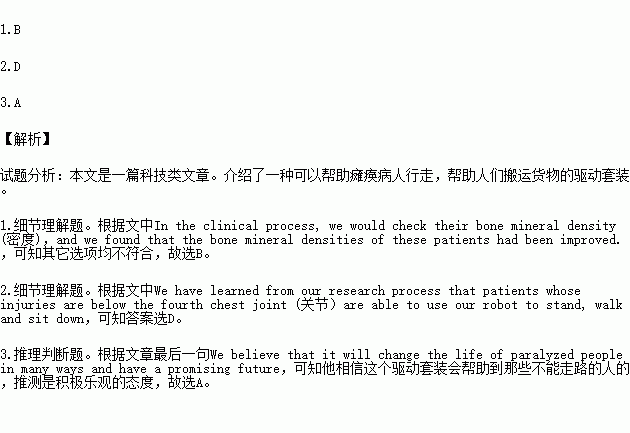题目内容
With the press of a button, a person with severe spinal cord (脊柱)injuiy is able to walk again, thanks to the Walking Assistive Exoskeleton Robot (WAER).
Powered suits that could help paralyzed (瘫痪)people walk and others lift and carry heavy loads with ease have been a dream since late 19th century. But they can realize their dreams in the 21st century.
The 20-kilogram robot has four battery-powered motors that can run for up to three hours. Inventor Wu Chenghua, from Taiwan’s Industrial Technology Research Institute, says it has successfully been in tests on 12 patients. “We have learned from our research process that patients whose injuries are below the fourth chest joint (关节)are able to use our robot to stand, walk and sit down,” he said.
Since walking contributes to muscle exercise, Wu says patients receive some additional benefits. “In the clinical process, we would check their bone mineral density (密度),and we found that the bone mineral densities of these patients had been improved.” he said. Wu says his exoskeleton may be available for consumers by 2018.
Meanwhile, baggage handlers at Tokyo’s Haneda Airport will soon start testing a similar robot, developed by the Japanese firm Cyberdyne. The battery-powered robot weighs only 3
lift a heavy object, the machine monitors the movemen”,says Yoshiyuki Sankai, the developer and CEO of Cyberdyne.
“This robot suit monitors the signal from the human nerve (神经)system to support the waist’s movement,” Sankai said, “It self-adjusts the level support to reduce the load on the human waist, light and smart. We believe that it will change the life of paralyzed people in many ways and have a promising future.”
1.With the help of WAER, patients will probably .
A. recover from spinal cord injury
B. improve their bone mineral density
C.walk as fast as normal people
D. monitor their waist’s movement
2.What can we learn about the invention of Wu Chenghua from the passage?
A.It weighs 3 kilograms and can run for up to three hours.
B.It will soon get tested at Tokyo’s Haneda Airport.
C.It may be put into use for consumers by the year 2028.
D.It can be used by patients with injuries below the fourth chest joint.
3.How does Sankai feel about the future of the robot suits?
A. Optimistic. B. Worried.
C. Doubtful. D. Puzzled.
 轻松课堂单元期中期末专题冲刺100分系列答案
轻松课堂单元期中期末专题冲刺100分系列答案
